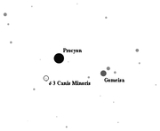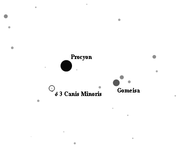
Delta3 Canis Minoris
Encyclopedia
- For other star systems with this Bayer designationBayer designationA Bayer designation is a stellar designation in which a specific star is identified by a Greek letter, followed by the genitive form of its parent constellation's Latin name...
, see Delta Canis MinorisDelta Canis MinorisThe Bayer designation Delta Canis Minoris is shared by three star systems, in the constellation Canis Minor:* δ¹ Canis Minoris* δ² Canis Minoris* δ³ Canis Minoris...
.

Star
A star is a massive, luminous sphere of plasma held together by gravity. At the end of its lifetime, a star can also contain a proportion of degenerate matter. The nearest star to Earth is the Sun, which is the source of most of the energy on Earth...
in the constellation
Constellation
In modern astronomy, a constellation is an internationally defined area of the celestial sphere. These areas are grouped around asterisms, patterns formed by prominent stars within apparent proximity to one another on Earth's night sky....
Canis Minor
Canis Minor
Canis Minor is a small constellation. It was included in the 2nd century astronomer Ptolemy's 48 constellations, and is still included among the 88 modern constellations...
. It is approximately 680 light years from Earth
Earth
Earth is the third planet from the Sun, and the densest and fifth-largest of the eight planets in the Solar System. It is also the largest of the Solar System's four terrestrial planets...
.
δ3 Canis Minoris is a white A-type
Stellar classification
In astronomy, stellar classification is a classification of stars based on their spectral characteristics. The spectral class of a star is a designated class of a star describing the ionization of its chromosphere, what atomic excitations are most prominent in the light, giving an objective measure...
main sequence dwarf
Main sequence
The main sequence is a continuous and distinctive band of stars that appears on plots of stellar color versus brightness. These color-magnitude plots are known as Hertzsprung–Russell diagrams after their co-developers, Ejnar Hertzsprung and Henry Norris Russell...
with an apparent magnitude
Apparent magnitude
The apparent magnitude of a celestial body is a measure of its brightness as seen by an observer on Earth, adjusted to the value it would have in the absence of the atmosphere...
of +5.83.

